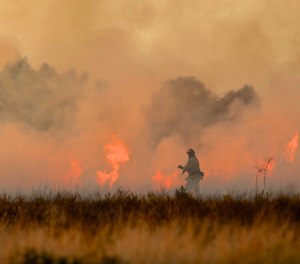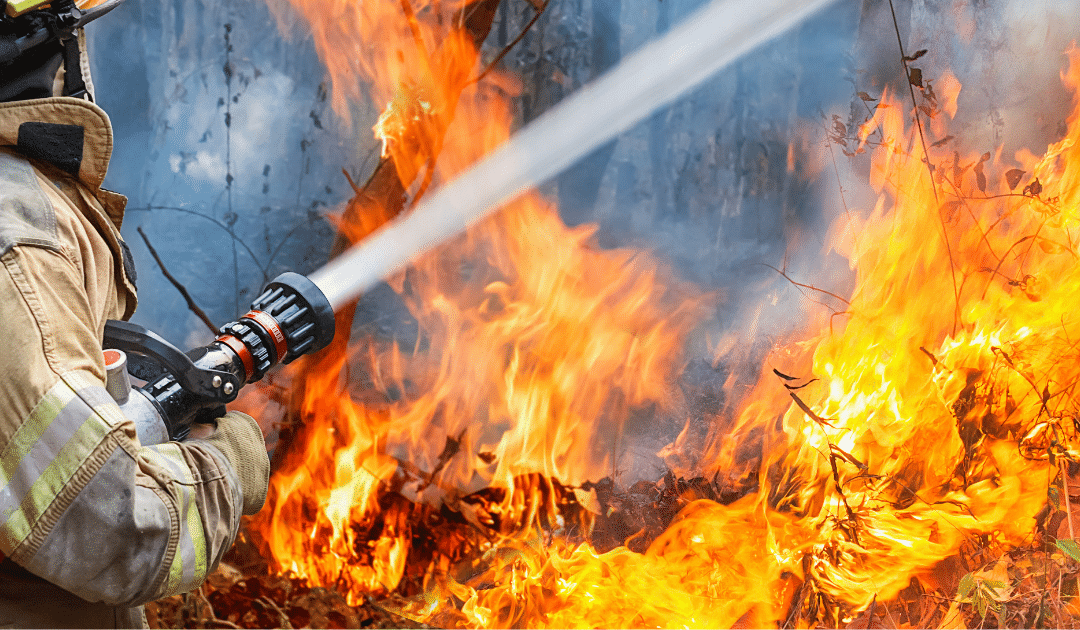As the country takes in terrifying images of the latest wildfires scorching communities in California, Oregon and beyond, Chief Scott D. Kerwood is thinking of the firefighters out working the blaze. He knows that as weary as they may be, many are continually running on empty, worrying more about protecting others than taking care of themselves.

While the business of being a firefighter is physically demanding – even when they’re not putting out house fires or dealing with other emergencies, putting out wildfires is grueling work. And it’s made even more difficult by harsh environmental conditions that cause physiological and emotional stress. That’s why Kerwood says it’s critical for firefighters to take breaks to hydrate, rest, decontaminate their gear and take other important steps to recover. If they don’t take the time to take care of themselves during those arduous emergency situations, Kerwood warned, firefighters, risk causing injuries to themselves and to the colleagues they are supposed to protect.
“The goal is that when they are done with this job, they can go home to their family at the end of their shift — or at the end of their career,” said Kerwood, who serves on the NFPA committee that reviews the rehabilitation guidelines and requirements spelled out in standard 1584.
Given that wildland firefighters are exposed to extreme heat and toxic substances for extended periods of time may make them vulnerable to certain types of cancer, heart disease, and other chronic illnesses. There are long-term performance and health benefits related to rehabilitation practices for wildland firefighters. Beyond helping to lessen the risk of serious illness, adding services provided on the scene may also help firefighters recover properly so that they’re ready for the next emergency.
Although fire professionals have been urging the rank and file first responders to use incident-based medical services, showers, decontamination stations, and other rehabilitation resources for at least a decade, the recent push to focus on wildland first responders may be in part due to what some industry experts consider troubling trends.
A recent study, for instance, suggests that drier conditions at higher elevations may explain why some wildfires have occurred in areas previously considered ‘too wet to burn.’ Ten-year data suggest that the average number of acres that burned has increased in some regions. In addition, regions are also seeing more and more residential and commercial developments built in wildlands. Because of these additions, it may be more likely that we start to see more of the 1.1 million career and volunteer firefighters in the U.S. putting out wildfires.
Hydrate, Eat, Rest, and Repeat
Firefighters who are seeking guidance or need to review rehab practices and protocols should consult NFPA standard 1584. The materials for this year’s Firefighter Safety Stand Down campaign include helpful studies and handouts on nutrition, mental health, exposure mitigation, and other issues. Kerwood said the first responders should also take the time to study their agency’s rehabilitation action plans.
“They need to be prepared to take care of their own safety, as well as that of the rest of their crew,” he said. “We should, when we check out our apparatus, for example, at the start of the shift make sure that we have all the rehab supplies we need on that truck,” including cooling towels, hydration packs, and breath analyzers that measure carbon monoxide levels in the body.
“Because existing rehabilitation protocols were largely designed for incidents in built environments that have rapid access to medical care, protective equipment and portable facilities, such as decontamination showers, firefighters deployed to wildfires shouldn’t assume that all agencies have the proper gear and supplies for those incidents,” said Nathan Trauernicht, chief of the University of California – Davis Fire Department.
“But that also doesn’t mean the first responders shouldn’t ask for what they need,” he said. “For example, if a department doesn’t have a decontamination shower on the trucks to clean equipment at the scene, firefighters should ask the agency to provide cleaning wipes.
“Still,” Trauernicht said, ”firefighters should follow the basics of rehabilitation every time they take a break. For starters, they must hydrate, hydrate, and hydrate some more — and if possible take electrolytes. Because they burn tons of calories, they should eat foods that help replenish them. Their rehab routine should also include oxygen, blood pressure, and heart rate checks.
Rest, of course, is a must. And if firefighters need grief counseling or other mental health services, they should ask for them.”
More Improvements Needed
According to Kerwood and Trauernicht, while it’s very important for firefighters to diligently follow wildfire rehabilitation practices, they also urge first responders to stay physically and mentally fit. Being disciplined about their exercise, water intake and nutritional habits help them lessen their risk of injury or developing serious chronic illness.
“You may be off duty and not planning on engaging in your regular work activities, but when we send a strike team out, we start doing a station recall or several stations of recall,” Trauernicht said. “And you’re now in a position where you may be next out to go to a significant incident that’s going to require you to be nourished, hydrated, and rested.”
Kerwood and Trauernicht are among fire professionals who say agencies should do everything they can to protect the men and women in their departments who risk their lives daily.
Because it may become more commonplace for firefighters across the nation to work wildfires, Kerwood and Trauernicht said agencies need to accelerate changes to their standard operating manuals to keep up with trends.
They also would like to see administrators be more thoughtful about the protective gear and equipment they buy for their firefighters, because of the different environments they may encounter. For instance, the personal protective equipment firefighters wear for structure fires often isn’t appropriate if they need to fight a wildfire, because they can make them overheat. “When battling a wildfire, it’s about striking the right balance between protecting personnel from the obvious hazards of flames and the oftentimes the less recognized risk of heat stress,” Trauernicht said.
Manufacturers of protective personal gear and firefighting equipment should continue to pursue options that make it easier and safer for firefighters to work on wildfires. Trauernicht said he would also like to see additional research and emphasis on the development of respiratory protection solutions they would be able to use in those incidents.
As more and more studies shed light on the associations between the toxic substances firefighters are exposed to, the newer generations of firefighters are going to demand better PPE, Standard Operation Procedures for rehabilitation operations, and rehabilitation resources.
“If you look at the old photographs, not of just structure firefighters, but you look at wildland firefighters, and you see them with ashes and smudges on their face, and their gear’s nasty,” Kerwood said. “I mean, we all prided ourselves in that. Now, the folks that we’ve got coming in, it’s like, ‘Really? You lived that way?’
Our job as fire chiefs and fire service leaders, therefore, is to make sure ‘Everyone Goes Home.’”
And now that also includes fire leaders doing all they can to protect firefighters from heat stress, chronic disease, and other serious conditions they could develop from fighting fires.
Sponsored by California Casualty
Written By Police1 BrandFocus Staff
- Graduation – When to Remove Your Child from Your Auto Policy - May 18, 2023
- How to Prevent Catalytic Converter Theft - May 17, 2023
- How Much Does Home Insurance Cost? - May 17, 2023

